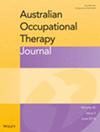The use of robotic upper limb therapy in routine clinical practice for stroke survivors: Insights from Australian therapists
Abstract
Introduction
There is a limited understanding of therapist acceptance and use of robot-assisted upper limb therapy (RT-ULT) in routine practice. The aim of this study was to explore the factors that influence Australian therapist acceptance and use of RT-ULT.
Methods
Two discipline-specific focus groups were conducted involving occupational therapists (n = 5) and physiotherapists (n = 4) who had used RT-ULT. Focus group questions were developed, and transcriptions analysed using the Theoretical Domains Framework (TDF). Additionally, participants scored the overall usability of the RT-ULT device with the System Usability Scale (SUS).
Consumer and Community Involvement
There was no direct involvement from consumers or community in this study.
Findings
Nine of the 14 domains of the TDF were covered in depth by participants during the focus groups: environmental context and resources, beliefs about consequences, knowledge, skills, decision-making, reinforcement, social influences, social/professional role and identity (single domain), and beliefs about capabilities. Physiotherapists recorded higher scores of the device on the SUS than the occupational therapists.
Conclusion
Both disciplines were accepting of RT-ULT, but it was physiotherapists who predominantly used RT-ULT in part due to the device being located in the physiotherapy rehabilitation gym. Other factors facilitating RT-ULT acceptance in practice included (1) increase in repetitive, intensive independent practice for stroke survivors, (2) ease of use, (3) strong patient acceptance, and (4) implementation process being clinician-led. Functional-based UL practice took priority over RT-ULT once stroke survivors demonstrated sufficient active movement and RT-ULT was not used in isolation but part of a combination of UL interventions.
PLAIN LANGUAGE SUMMARY
There is a little known about what therapists think about using robot-assisted upper limb therapy in their daily practice. The aim of this study was to explore Australian therapist perceptions of the use of robotics.
Focus groups were conducted separately with five occupational therapists and four physiotherapists who had used robotics at their rehabilitation facility. In addition to the focus groups, each therapist scored the user-friendliness of the robotic device by completing a short survey.
Both occupational therapists and physiotherapists believed the robotics was a beneficial addition to the rehabilitation facility. Physiotherapists used the device more than the occupational therapists with the device being located in the physiotherapy area of the rehabilitation facility. Therapists explained that robotics increased the amount of practice stroke survivors could do, was easy to use, and was motivating for stroke survivors. However, once stroke survivors had gained enough arm movement, the focus moved to practicing actual daily tasks rather than robotics. Also, robotics was not the only form of upper limb therapy offered to stroke survivors with multiple upper limb treatments used to aid their recovery.

 求助内容:
求助内容: 应助结果提醒方式:
应助结果提醒方式:


